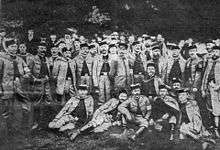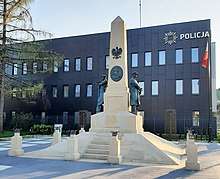Czechowice-Dziedzice
Czechowice-Dziedzice [t͡ʂɛxɔˈvit͡sɛ d͡ʑɛˈd͡ʑit͡sɛ] (![]()
Czechowice-Dziedzice | |
|---|---|
 John Paul II Square | |
 Flag  Coat of arms | |
 Czechowice-Dziedzice | |
| Coordinates: 49°54′47″N 19°0′23″E | |
| Country | |
| Voivodeship | Silesian |
| County | Bielsko |
| Gmina | Czechowice-Dziedzice |
| Government | |
| • Mayor | Marian Błachut |
| Area | |
| • Total | 32.98 km2 (12.73 sq mi) |
| Population (2019-06-30[1]) | |
| • Total | 35,926 |
| • Density | 1,100/km2 (2,800/sq mi) |
| Time zone | UTC+1 (CET) |
| • Summer (DST) | UTC+2 (CEST) |
| Postal code | 43-502, 43-503, 43-500 |
| Car plates | SBI |
| Website | http://www.czechowice-dziedzice.pl |
History
The area inhabited by the Golensizi tribe probably became part of Poland under Mieszko I of Poland, but the first certain historical mentions pertaining to the region began to appear much later. The village of Czechowice was first mentioned in a Latin document of Diocese of Wrocław called Liber fundationis episcopatus Vratislaviensis from around 1305 as two settlements:[3]
Item in Chothowitz theutonico fertones
Item in Chothowitz polonico decima more polonico, valet I) marcam
Chotowitz theutonico (German Czechowice) was presumably established under German rights (iure theuthonico) on the ground of the older Chotowitz polonico, which was continuously ruling itself under Polish traditional rights (iure polonico).[4] The declared size of a tithe paid by villagers was also suggesting that it was an old and quite developed community.[5] It belonged then to the Duchy of Teschen, formed in 1290, since 1327 a fee of the Kingdom of Bohemia. In 1430 the village was first mentioned under the current name of Czechowice rather than Chatowice. Dziedzice were first mentioned in 1465. The other medieval village that was later absorbed by Czechowice was Żebracz, first mentioned in 1443.[6]
The village of Czechowice became a seat of a Catholic parish, mentioned in the register of Peter's Pence payment from 1447 among 50 parishes of Teschen deanery as Czechowicz.[7] In the time of Protestant Reformation, the parish of Czechowice stayed Roman Catholic, conversely to the nearby town of Bielsko and the rest of the Duchy of Teschen.
19th and 20th centuries

After Revolutions of 1848 in the Austrian Empire, a modern municipal division was introduced in the re-established Austrian Silesia. The villages as two separate municipalities were subscribed to the political and legal district of Bielsko. In 1855, a local line of the important Emperor Ferdinand Northern Railway was opened to traffic with a station in Dziedzice. This led to a rapid industrialization of Dziedzice and Czechowice, especially in the late 19th century. At that time, Czechowice and Dziedzice became strong centers of the Polish national movement in stark contrast to German-dominated town of Bielsko, whose inhabitants used to call the area of Czechowice and Dziedzice verfluchte polnische Winkel (cursed Polish corner).[8][9] Polish school, pedagogical, sports and other organizations were established here.[9]
According to the censuses conducted in 1880, 1890, 1900 and 1910, the population of Czechowice grew from 2804 in 1880 to 7056 in 1910 with a dwindling majority being native Polish-speakers (from 96.6% in 1880 to 86.7% in 1910) accompanied by a growing German-speaking minority (from 95 or 3.4% in 1880 to 611 or 8.9% in 1910) and Czech-speaking (from 33 or 1.1% in 1890 to 290 or 4.3% in 1910), in terms of religion in 1910 majority were Roman Catholics (94.1%), followed by Protestants (231 or 3.3%), Jews (176 or 2.5) and 9 people adhering to yet another faith.[10] Whereas, in case of Dziedzice, the population of the municipality grew from 1011 in 1880 to 2436 in 1910 with a majority being native Polish-speakers (between 748 or 78% in 1880 and 1994 or 85.1% in 1910, at most 938 or 92.1% in 1890) accompanied by a German-speaking minority (189 or 19.7% in 1880, then at most 266 or 11.4% in 1910) and Czech-speaking (at most 81 or 3.5% in 1910), in terms of religion in 1910 majority were Roman Catholics (88.6%), followed by Jews (185 or 7.6%) and Protestants (93 or 3.8%).[10]

After World War I, fall of Austria-Hungary, the reestablishment of independent Poland, the Polish–Czechoslovak War and the division of Cieszyn Silesia in 1920, Czechowice and Dziedzice became a part of Poland. In the interwar period, the industry continued to expand.[9] New factories were founded, which produced machines, bicycles, matches, paper, cables etc.[9] New culture centers, amateur theaters, cinemas, choirs and sports clubs were founded.[9] In 1924, the Freedom Monument (Pomnik Wolności) was unveiled, financed by voluntary contributions.[11] Patriotic celebrations take place at the monument.[11]
Czechowice and Dziedzice were annexed by Nazi Germany at the beginning of World War II in September 1939. The local population was subjected to deportations for work into Nazi Germany and to concentration camps, expropriations, street round-ups, death sentences and public executions.[9] Polish social and political life, as well as Polish education were being destroyed.[9] During the Oil Campaign of World War II, the oil refinery at "Czechowice" was bombed on August 20, 1944. The Tschechowitz I & II subcamps of Auschwitz in Czechowice-Dziedzice provided forced labor for the SOCONY-Vacuum oil plant.[12] After the war they were restored to Poland.
In 1951, Dziedzice were merged with Czechowice, concurrently the expanded gmina was given town rights.[13] However, the name of the new town was Czechowice, which disappointed the citizens of Dziedzice. After complaints in 1958, the town was given the name of Czechowice-Dziedzice.[14]
From 1975 to 1998, it was located in the Katowice Voivodeship, and since 1999 in Silesian Voivodeship.
In 1993, a new Freedom Monument was erected in place of the former, destroyed by the Germans in 1939.[11]
Landmarks

Among the town's landmarks are the Rococo Kotuliński Palace, the Baroque Saint Catherine Church and the Gothic Revival Saint Mary of Help church.
Twin towns – sister cities
Notable people
- Piotr Beczała, operatic tenor
- Grzegorz Borawski, retired football defender
Gallery
- Saint Mary of Help church
- Town hall
 The oldest church of St. Catherine
The oldest church of St. Catherine Silesia coal mine
Silesia coal mine- Workers' houses in Żebracz
- Primary school
References
- "Population. Size and structure and vital statistics in Poland by territorial divison in 2019. As of 30th June". stat.gov.pl. Statistics Poland. 2019-10-15. Retrieved 2020-02-14.
- Urząd Miejski w Czechowicach-Dziedzicach: Rozwój miasta
- Panic, Idzi (2010). Śląsk Cieszyński w średniowieczu (do 1528) [Cieszyn Silesia in Middle Ages (until 1528)] (in Polish). Cieszyn: Starostwo Powiatowe w Cieszynie. p. 297. ISBN 978-83-926929-3-5.
- I. Panic, 2010, p. 401
- I. Panic, 2010, p. 402
- I. Panic, 2010, p. 313
- "Registrum denarii sancti Petri in archidiaconatu Opoliensi sub anno domini MCCCCXLVII per dominum Nicolaum Wolff decretorum doctorem, archidiaconum Opoliensem, ex commissione reverendi in Christo patris ac domini Conradi episcopi Wratislaviensis, sedis apostolice collectoris, collecti". Zeitschrift des Vereins für Geschichte und Alterthum Schlesiens (in German). Breslau: H. Markgraf. 27: 361–372. 1893. Retrieved 21 July 2014.
- Wnętrzak, Grzegorz (2014). Stosunki polityczne i narodowościowe na pograniczu Śląska Cieszyńskiego i Galicji zachodniej w latach 1897-1920. Toruń: Wydawnictwo Adam Marszałek. ISBN 978-83-7780-882-5.
- "Z historii Czechowic-Dziedzic". Urząd Miejski w Czechowicach-Dziedzicach (in Polish). Retrieved 2 October 2019.
- Piątkowski, Kazimierz (1918). Stosunki narodowościowe w Księstwie Cieszyńskiem (in Polish). Cieszyn: Macierz Szkolna Księstwa Cieszyńskiego. pp. 257, 276.
- "Pomnik Wolności". Urząd Miejski w Czechowicach-Dziedzicach (in Polish). Retrieved 2 October 2019.
- "Sub-Camps of Auschwitz Concentration Camp". Auschwitz-Birkenau: Memorial and Museum. auschwitz.org.pl. Archived from the original on 2009-06-02. Retrieved 2009-05-21.
- Rozporządzenie Prezesa Rady Ministrów z dnia 14 grudnia 1950 r. w sprawie zniesienia gminy Dziedzice, zmiany granic niektórych gmin oraz nadania ustroju miejskiego gminie Czechowice., Dz. U. z 1950 r. Nr 57, poz. 514
- Zarządzenie nr 231 Prezesa Rady Ministrów z dnia 13 listopada 1958 r. w sprawie zmiany nazw niektórych miejscowości w województwach katowickim, poznańskim, wrocławskim i lubelskim., M.P. z 1958 r. Nr 89, poz. 496
External links
- (in Polish) Czechowice - Dziedzice on the web
- Jewish Community in Czechowice-Dziedzice on Virtual Shtetl
| Wikimedia Commons has media related to Czechowice-Dziedzice. |

